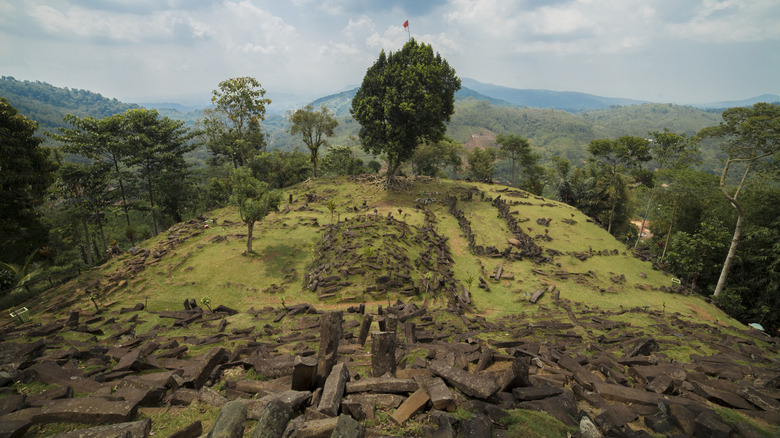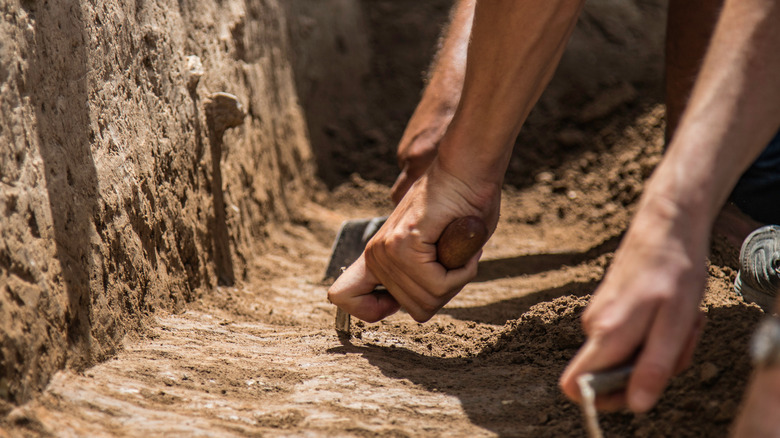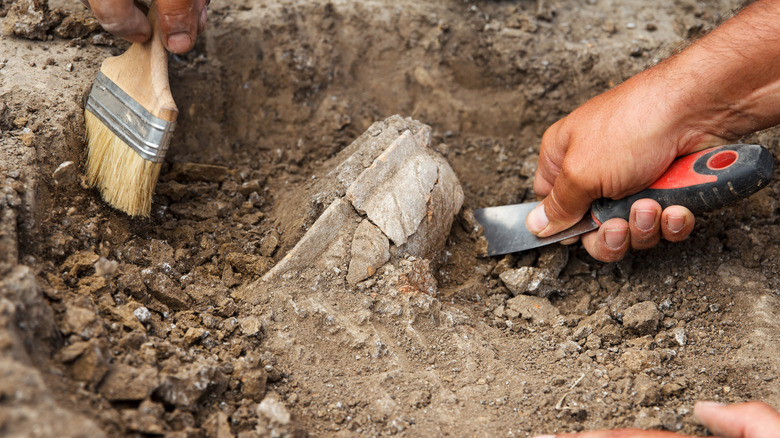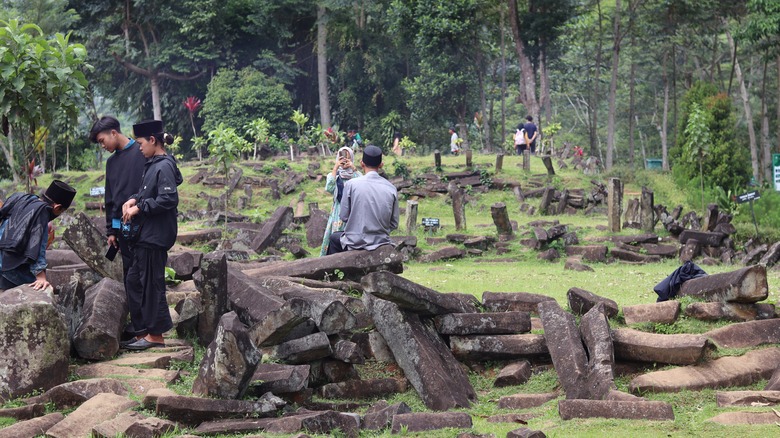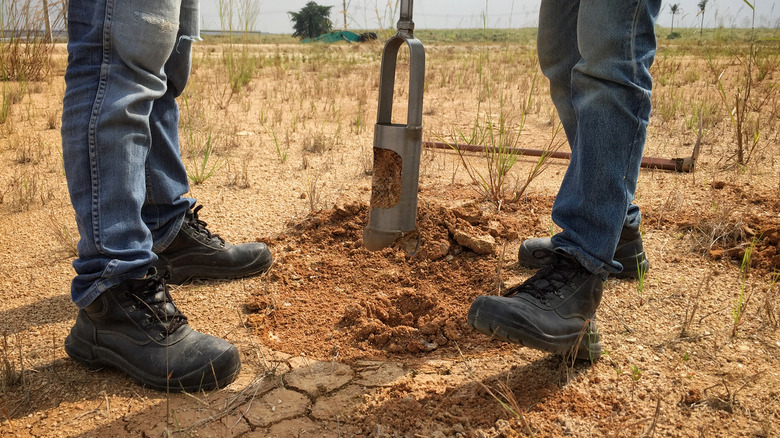Why The Excavation Of The So-Called World's Oldest Pyramid Is So Controversial
This megalithic site is thought to be among the oldest in the world, home to a pyramid in Java that was buried centuries ago, according to The Sydney Morning Herald. Before a highly controversial excavation, no one knew exactly how old the buried Indonesian pyramid of Gunung Padang was.
It was no secret that there were ancient relics on the top of Gunung Padang, per Insider, but for a long time, no one knew that there was also very old pyramid hidden underneath. And it wasn't just hidden once — several civilizations seemingly built on top of the hidden remains. They disguised it so well that it just looked like the other rock formations that blended into the environment around it.
By 2013, per The Sydney Morning Herald, geologist Danny Hilman's research into Gunung Padang was deemed so important that President Susilo Bambang Yudhoyono was actively involved in the newest research efforts. The project would go on to incite fury in archaeologists and geologists worldwide.
Controversies from the start
Through Indonesia's Centre for Geotechnical Research, Hilman had been leading slow digs at Gunung Padang, reaching only about 19 inches in one dig (via The Sydney Morning Herald). He then dug about 13 feet the next time, and he kept finding relics from between the years of 500 B.C. to 5200 B.C.
The first controversy came with the Red and White Glory operation, in which regular people were recruited to do the delicate task of unearthing the old pyramid. It wasn't just a few people — they wanted to involve 500 untrained volunteers, according to "Indonesia's Own 'Pyramid': The Imagined Past and Nationalism of Gunung Padang," published in the International Review of Humanities Studies (posted at ResearchGate).
This caused a huge uproar and a petition from experts in the region, per The Sydney Morning Herald. But Hilman and his team still wanted to keep digging, and they got their chance in 2014.
The controversial dig
According to The Jakarta Post, the budget for the 2014 project was around $318,532 U.S., which would pay for Hilman's six-person team to work for two weeks. This already caused controversy among other scientists who received far less money for their projects. The geological reality is there were 127 volcanoes that scientists needed to keep an eye on, and needed money and resources for. As the leader of the Volcanology and Geological Hazard Mitigation Center, Surono, explained, "Our country is also prone to landslides, earthquakes, and tsunamis ... We're focusing on short-term research to support disaster mitigation." So the project pulled resources from more pressing matters, even though it was to pursue important historical research.
Hilman's team had to work fast (via The Jakarta Post). So a team of Indonesian soldiers grabbed hoes and began hacking away at one of the oldest historical sites on planet Earth. The soldiers dug away at least six feet of rocky terrain at the east and west ends of Gunung Padang, so that way the researchers could investigate the insides. They were then blocked by a wall of sand more than six feet deep.
The reaction to the botched dig
The 2014 excavation techniques of Gunung Padang became a controversy that was immediately lambasted by experts, per The Jakarta Post. Using hoes to excavate one of the world's oldest sites is problematic because delicate and small remnants could easily be destroyed forever. After all, if the site really was created by humans from at least three different eras of civilization, as Hilman believed, why not be as careful as possible to preserve what is found (via The Sydney Morning Herald)?
The head of the Bandung Archaeological Center head, Desril Riva Shanti, said in no uncertain terms that the excavation should have never happened like that, according to The Jakarta Post. Instead, the team should have taken their time and worked slowly on the project using much tinier tools.
Per "Indonesia's Own 'Pyramid': The Imagined Past and Nationalism of Gunung Padang," the team caused an outcry when other researchers found out that they had removed columnar joints without snapping photos or documenting their positions first. Archaeologists said that the team didn't pay enough attention to the site's stratigraphy, meaning the team hadn't documented where objects were before moving them around, which would have provided important context in this ancient triple-layered excavation.
There are other research methods
As Scientific American points out, there are lots of less invasive ways to explore a prehistoric buried pyramid. To avoid unnecessary damage to the structure in more recent years, researchers have used x-rays, 2D or 3D imaging, radar scans, and other methods to record new findings. Since the layers of rock range from 3,000 to 28,000 years old, using gentle discovery techniques protects the sacred structure.
But the controversy gets even more compelling. As The Jakarta Post reports, members of the dig didn't even immediately disclose everything they found. Never-before-seen coins were unearthed during the speedy 2014 excavation, as were ceramic pieces, metals, and pottery.
The team admitted that they didn't immediately disclose their findings, especially details about the unique coins, because they realized it would be a controversial discovery. That's because, according to National Geographic Indonesia, other archaeologists dispute the claim that the coins are from 5200 B.C. — that would mean the coins were way older than other researchers believed they could be.
What else is in these ancient sites?
The Secretary of the Gunung Padang Research and Management National Team, Erick Ridzky, was excited by the discovery — until that point, no one knew for certain what lay beneath Mount Padang (via Tribun Jabar). The research team could now present their evidence to pursue fresh funding. The team reported their findings to Indonesia's Minister of Education and Culture in October of 2014.
Per Insider, the top layer of Gunung Padang ended up being around 3,500 years old, the middle layer about 8,000 years old, and the bottommost layer indicated it was between 9,000 to 28,000 years old. As Live Science reports, Hilman believes the structure is a temple unlike any seen before, due to its odd shape. The researchers concluded that ancient civilizations probably gathered on top of the temple hill to worship, while down in the pyramid were numerous chambers. The Jakarta Post reports that Hilman even found what he believes are hand-crafted rooms that ancient humans made ages ago.
The team plans to keep exploring the ancient site, but instead they will use the method of core drilling to gain information about one of the world's oldest megalithic sites. With the success of the 2014 dig, they were granted all the future funding they want by the Education and Culture Ministry.
